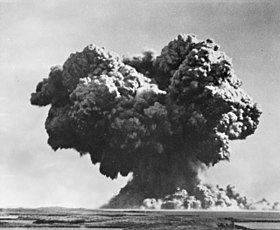
Back عملية الإعصار (اختبار نووي) Arabic Ураган (операция) Bulgarian Operation Hurricane (Australien) German Operación Hurricane Spanish Operaatio Hurrikaani (ydinkoe) Finnish Opération Hurricane French מבצע הוריקן HE Operasi Hurricane ID Operazione Hurricane Italian ハリケーン作戦 Japanese
| Operation Hurricane | |
|---|---|
 The mud-laden cauliflower explosion | |
| Information | |
| Country | United Kingdom |
| Test site | Trimouille Island, Montebello Islands, Western Australia 20°24′19″S 115°33′59″E / 20.40528°S 115.56639°E |
| Date | 23:59:24 UTC, 2 October 1952 |
| Number of tests | 1 |
| Test type | Ship |
| Max. yield | 25 kilotons of TNT (100 TJ) |
| Test series chronology | |
Operation Hurricane was the first test of a British atomic device. A plutonium implosion device was detonated on 3 October 1952 in Main Bay, Trimouille Island, in the Montebello Islands in Western Australia. With the success of Operation Hurricane, the United Kingdom became the third nuclear power, after the United States and the Soviet Union.
During the Second World War, Britain commenced a nuclear weapons project, code-named Tube Alloys, but the 1943 Quebec Agreement merged it with the American Manhattan Project. Several key British scientists worked on the Manhattan Project, but after the war the American government ended cooperation on nuclear weapons. In January 1947, a cabinet sub-committee decided to resume British efforts to build nuclear weapons, in response to an apprehension of American isolationism and fears of Britain losing its great power status. The project was called High Explosive Research, and was directed by Lord Portal, with William Penney in charge of bomb design.
Implicit in the decision to develop atomic bombs was the need to test them. The preferred site was the Pacific Proving Grounds in the US-controlled Marshall Islands. As a fallback, sites in Canada and Australia were considered. The Admiralty suggested that the Montebello Islands might be suitable, so the Prime Minister of the United Kingdom, Clement Attlee, sent a request to the Prime Minister of Australia, Robert Menzies. The Australian government formally agreed to the islands being used as a nuclear test site in May 1951. In February 1952, Attlee's successor, Winston Churchill, announced in the House of Commons that the first British atomic bomb test would occur in Australia before the end of the year.
A small fleet was assembled for Operation Hurricane under the command of Rear Admiral A. D. Torlesse; it included the escort carrier HMS Campania, which served as the flagship, and the LSTs Narvik, Zeebrugge and Tracker. Leonard Tyte from the Atomic Weapons Research Establishment at Aldermaston was appointed the technical director. The bomb for Operation Hurricane was assembled (without its radioactive components) at Foulness and taken to the frigate HMS Plym for transport to Australia. On reaching the Montebello Islands, the five Royal Navy ships were joined by eleven Royal Australian Navy ships, including the aircraft carrier HMAS Sydney. To test the effects of a ship-smuggled atomic bomb on a port (a threat of great concern to the British at the time), the bomb was exploded inside the hull of Plym, anchored 350 metres (1,150 ft) off Trimouille Island. The explosion occurred 2.7 metres (8 ft 10 in) below the water line and left a saucer-shaped crater on the seabed 6 metres (20 ft) deep and 300 metres (980 ft) across.